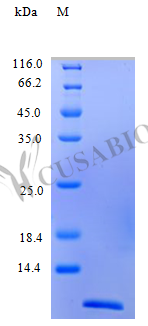Our recombinant human CCL22 protein was produced in E. coli, covering the mature protein sequence from amino acids 25-93. The tag-free protein is offered as a lyophilized powder for convenient reconstitution using sterile water or buffer. With a purity of >97%, as confirmed by SDS-PAGE and HPLC, our recombinant CCL22 has an endotoxin level of less than 1.0 EU/µg, as determined by the LAL method. The protein is fully biologically active, as shown in a chemotaxis bioassay with human T-lymphocytes, where it displays activity in a concentration range of 10-100 ng/ml.
Belonging to the CC chemokine family, C-C motif chemokine 22 (CCL22) plays a significant role in regulating immune cell trafficking and function. Investigating the functions and mechanisms of CCL22 is crucial for understanding its impact on the immune system and identifying potential therapeutic targets for immune-related conditions.






